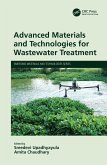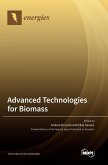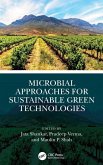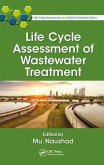Green Technologies for Wastewater Treatment and Bioenergy Production
Herausgeber: Ahmad, Imran
Green Technologies for Wastewater Treatment and Bioenergy Production
Herausgeber: Ahmad, Imran
- Gebundenes Buch
- Merkliste
- Auf die Merkliste
- Bewerten Bewerten
- Teilen
- Produkt teilen
- Produkterinnerung
- Produkterinnerung
Researchers have been working to find green technologies for the sustainable and economically viable treatment methods for wastewater, and Green Technologies for Wastewater Treatment and Bioenergy Production focuses on these latest advancements
Andere Kunden interessierten sich auch für
![Innovative and Hybrid Technologies for Wastewater Treatment and Recycling Innovative and Hybrid Technologies for Wastewater Treatment and Recycling]() Innovative and Hybrid Technologies for Wastewater Treatment and Recycling189,99 €
Innovative and Hybrid Technologies for Wastewater Treatment and Recycling189,99 €![Advanced Materials and Technologies for Wastewater Treatment Advanced Materials and Technologies for Wastewater Treatment]() Advanced Materials and Technologies for Wastewater Treatment169,99 €
Advanced Materials and Technologies for Wastewater Treatment169,99 €![Bioenergy Production by Anaerobic Digestion Bioenergy Production by Anaerobic Digestion]() Bioenergy Production by Anaerobic Digestion60,99 €
Bioenergy Production by Anaerobic Digestion60,99 €![Advanced Technologies for Biomass Advanced Technologies for Biomass]() Advanced Technologies for Biomass78,99 €
Advanced Technologies for Biomass78,99 €![Microbial Approaches for Sustainable Green Technologies Microbial Approaches for Sustainable Green Technologies]() Microbial Approaches for Sustainable Green Technologies114,99 €
Microbial Approaches for Sustainable Green Technologies114,99 €![Wastewater Treatment and Reuse Theory and Design Examples, Volume 2 Wastewater Treatment and Reuse Theory and Design Examples, Volume 2]() Syed R. QasimWastewater Treatment and Reuse Theory and Design Examples, Volume 2179,99 €
Syed R. QasimWastewater Treatment and Reuse Theory and Design Examples, Volume 2179,99 €![Life Cycle Assessment of Wastewater Treatment Life Cycle Assessment of Wastewater Treatment]() Life Cycle Assessment of Wastewater Treatment205,99 €
Life Cycle Assessment of Wastewater Treatment205,99 €-
-
-
Researchers have been working to find green technologies for the sustainable and economically viable treatment methods for wastewater, and Green Technologies for Wastewater Treatment and Bioenergy Production focuses on these latest advancements
Produktdetails
- Produktdetails
- Verlag: CRC Press
- Seitenzahl: 466
- Erscheinungstermin: 27. März 2025
- Englisch
- Abmessung: 240mm x 161mm x 29mm
- Gewicht: 860g
- ISBN-13: 9781032604671
- ISBN-10: 1032604670
- Artikelnr.: 71910259
- Herstellerkennzeichnung
- Libri GmbH
- Europaallee 1
- 36244 Bad Hersfeld
- gpsr@libri.de
- Verlag: CRC Press
- Seitenzahl: 466
- Erscheinungstermin: 27. März 2025
- Englisch
- Abmessung: 240mm x 161mm x 29mm
- Gewicht: 860g
- ISBN-13: 9781032604671
- ISBN-10: 1032604670
- Artikelnr.: 71910259
- Herstellerkennzeichnung
- Libri GmbH
- Europaallee 1
- 36244 Bad Hersfeld
- gpsr@libri.de
Dr. Imran Ahmad is a dedicated researcher, academic, and scientific consultant deeply committed to environmental sustainability and algae biotechnology. With an MPhil and PhD from Universiti Teknologi Malaysia, his expertise lies in biological wastewater treatment, microalgal bioremediation, and resource recovery. His work bridges research and application, focusing on innovative solutions that address environmental challenges while contributing to the principles of a circular bioeconomy. He has been actively involved in designing and optimizing photobioreactors, anaerobic reactors, and microalgae-based treatment systems that offer sustainable alternatives for wastewater management and carbon sequestration. He works as a Scientific Consultant and Bioprocess Engineer with ProAlgaeTech, a startup focused on microalgal carbon sequestration and wastewater bioremediation. His contributions extend beyond academic research, engaging in industrial applications that translate scientific advancements into real-world impact. He has been integral to international projects, including the Indo-European Horizon 2020 PAVITR project and Liquid Trees, where his insights have helped shape strategies for efficient wastewater treatment and bioenergy production. He also obtained a utility innovation for a modified grease trap design for restaurant wastewater, further demonstrating his ability to develop practical engineering solutions. His research has resulted in various high-impact publications, reflecting his commitment to advancing knowledge in environmental engineering. His work has been recognized at both national and international levels. He has received the My Membrane Award from the Malaysia Membrane Society, UTM, and has been acknowledged by Japan's Algae Industry Incubation Consortium. He was also nominated as the Secretary of the International Conference on Environmental Science and Green Technology in 2022. Alongside his research contributions, he has spent more than eight years in academia, mentoring students, designing laboratory infrastructure, and fostering interdisciplinary collaborations. His experience in teaching and research has allowed him to contribute to shaping the future of environmental engineering education. Beyond professional achievements, he remains committed to developing sustainable technologies that create meaningful change. His work is driven by the belief that scientific research should lead to practical, lasting solutions that benefit the environment and society. Whether through academia, consultancy, or industry partnerships, he continues exploring ways to integrate innovation with sustainability, ensuring that his contributions have a lasting impact on green technology.
Chapter 1: An Introduction to Green Technologies for Wastewater Treatment
Chapter 2: Bioremediation: An Innovative Approach for Wastewater Treatment
Chapter 3: Investigating Ecological Friendly Advancements in Wastewater
Treatment for Sustainable Solutions
Chapter 4: Harnessing Microalgae for Wastewater Treatment: Optimizing
Cultivation, Pollutant Removal, and Photobioreactor Technologies for a
Sustainable Future
Chapter 5: Microalgal treatment of wastewater by suspended and immobilized
algal systems: An approach contributing to circular bioeconomy
Chapter 6: Microalgae-Bacteria Symbiotic System for Wastewater Treatment
Chapter 7: Potential of Macroalgae (Seaweeds) in the treatment of
wastewaters
Chapter 8: Open and closed photobioreactors for algal wastewater treatment
Chapter 9: Microbial Nanomaterials for the Treatment of Wastewaters
Chapter 10: Treatment Of Wastewater Using Nanoparticles From Seaweeds
(Marine Algae)
Chapter 11: Metagenomics: Hidden Details of Microbes Involved in Wastewater
Treatment
Chapter 12: Biofuels production from micro/macroalgae cultivated with
wastewaters
Chapter 13: Biomethane production from the anaerobic digestion of
wastewater: An Introduction
Chapter 14: Biomethane production from the anaerobic digestion of
wastewater: Process, Mechanism & Cost Analysis
Chapter 15: Biohydrogen: A green fuel for sustainable energy
Chapter 16: Carbon Sequestration and Wastewater Treatment: An Approach to
Reduce Carbon Footprint
Chapter 17: Circular Bioeconomy: An Environmentally Sustainable and
Economically Viable Approach to Wastewater Treatment
Chapter 2: Bioremediation: An Innovative Approach for Wastewater Treatment
Chapter 3: Investigating Ecological Friendly Advancements in Wastewater
Treatment for Sustainable Solutions
Chapter 4: Harnessing Microalgae for Wastewater Treatment: Optimizing
Cultivation, Pollutant Removal, and Photobioreactor Technologies for a
Sustainable Future
Chapter 5: Microalgal treatment of wastewater by suspended and immobilized
algal systems: An approach contributing to circular bioeconomy
Chapter 6: Microalgae-Bacteria Symbiotic System for Wastewater Treatment
Chapter 7: Potential of Macroalgae (Seaweeds) in the treatment of
wastewaters
Chapter 8: Open and closed photobioreactors for algal wastewater treatment
Chapter 9: Microbial Nanomaterials for the Treatment of Wastewaters
Chapter 10: Treatment Of Wastewater Using Nanoparticles From Seaweeds
(Marine Algae)
Chapter 11: Metagenomics: Hidden Details of Microbes Involved in Wastewater
Treatment
Chapter 12: Biofuels production from micro/macroalgae cultivated with
wastewaters
Chapter 13: Biomethane production from the anaerobic digestion of
wastewater: An Introduction
Chapter 14: Biomethane production from the anaerobic digestion of
wastewater: Process, Mechanism & Cost Analysis
Chapter 15: Biohydrogen: A green fuel for sustainable energy
Chapter 16: Carbon Sequestration and Wastewater Treatment: An Approach to
Reduce Carbon Footprint
Chapter 17: Circular Bioeconomy: An Environmentally Sustainable and
Economically Viable Approach to Wastewater Treatment
Chapter 1: An Introduction to Green Technologies for Wastewater Treatment
Chapter 2: Bioremediation: An Innovative Approach for Wastewater Treatment
Chapter 3: Investigating Ecological Friendly Advancements in Wastewater
Treatment for Sustainable Solutions
Chapter 4: Harnessing Microalgae for Wastewater Treatment: Optimizing
Cultivation, Pollutant Removal, and Photobioreactor Technologies for a
Sustainable Future
Chapter 5: Microalgal treatment of wastewater by suspended and immobilized
algal systems: An approach contributing to circular bioeconomy
Chapter 6: Microalgae-Bacteria Symbiotic System for Wastewater Treatment
Chapter 7: Potential of Macroalgae (Seaweeds) in the treatment of
wastewaters
Chapter 8: Open and closed photobioreactors for algal wastewater treatment
Chapter 9: Microbial Nanomaterials for the Treatment of Wastewaters
Chapter 10: Treatment Of Wastewater Using Nanoparticles From Seaweeds
(Marine Algae)
Chapter 11: Metagenomics: Hidden Details of Microbes Involved in Wastewater
Treatment
Chapter 12: Biofuels production from micro/macroalgae cultivated with
wastewaters
Chapter 13: Biomethane production from the anaerobic digestion of
wastewater: An Introduction
Chapter 14: Biomethane production from the anaerobic digestion of
wastewater: Process, Mechanism & Cost Analysis
Chapter 15: Biohydrogen: A green fuel for sustainable energy
Chapter 16: Carbon Sequestration and Wastewater Treatment: An Approach to
Reduce Carbon Footprint
Chapter 17: Circular Bioeconomy: An Environmentally Sustainable and
Economically Viable Approach to Wastewater Treatment
Chapter 2: Bioremediation: An Innovative Approach for Wastewater Treatment
Chapter 3: Investigating Ecological Friendly Advancements in Wastewater
Treatment for Sustainable Solutions
Chapter 4: Harnessing Microalgae for Wastewater Treatment: Optimizing
Cultivation, Pollutant Removal, and Photobioreactor Technologies for a
Sustainable Future
Chapter 5: Microalgal treatment of wastewater by suspended and immobilized
algal systems: An approach contributing to circular bioeconomy
Chapter 6: Microalgae-Bacteria Symbiotic System for Wastewater Treatment
Chapter 7: Potential of Macroalgae (Seaweeds) in the treatment of
wastewaters
Chapter 8: Open and closed photobioreactors for algal wastewater treatment
Chapter 9: Microbial Nanomaterials for the Treatment of Wastewaters
Chapter 10: Treatment Of Wastewater Using Nanoparticles From Seaweeds
(Marine Algae)
Chapter 11: Metagenomics: Hidden Details of Microbes Involved in Wastewater
Treatment
Chapter 12: Biofuels production from micro/macroalgae cultivated with
wastewaters
Chapter 13: Biomethane production from the anaerobic digestion of
wastewater: An Introduction
Chapter 14: Biomethane production from the anaerobic digestion of
wastewater: Process, Mechanism & Cost Analysis
Chapter 15: Biohydrogen: A green fuel for sustainable energy
Chapter 16: Carbon Sequestration and Wastewater Treatment: An Approach to
Reduce Carbon Footprint
Chapter 17: Circular Bioeconomy: An Environmentally Sustainable and
Economically Viable Approach to Wastewater Treatment









